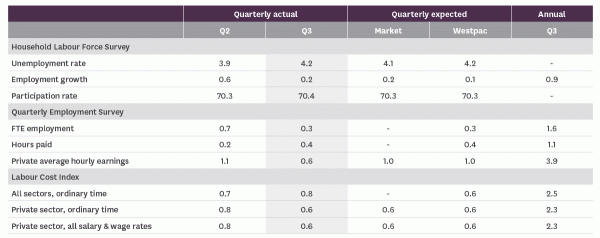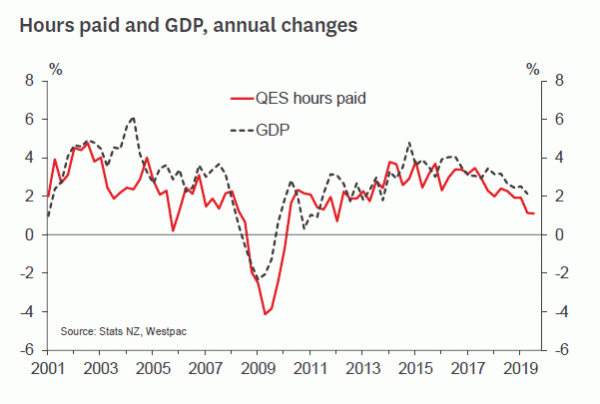- New Zealand’s unemployment rate rose to 4.2% in the September quarter, reversing its surprising drop last quarter.
- The unemployment rate has flattened out as economic growth has slowed, but is still at levels consistent with a tight labour market.
- Annual wage growth rose to a new tenyear high, partly boosted by public sector pay agreements.
- The labour market is in a stronger condition than the Reserve Bank expected in its previous forecasts. Our forecast remains for no change to the OCR at next week’s review.
The surveys for the September quarter continued to paint a mixed picture about the state of New Zealand’s labour market. Jobs growth has slowed over the last year or so as the economy has cooled, but workers remain in short supply and wage inflation is gradually building. The results were in line with our forecasts, but they suggest a stronger labour market than the Reserve Bank was anticipating.
The unemployment rate rose to 4.2% in the September quarter, reversing the fall to an 11-year low of 3.9% that we saw in the June quarter. That previous result came as a surprise to everyone, given the evidence that economic growth was slowing and the demand for workers had cooled. We suspected that there was some survey noise involved, and the subsequent reversal supports that view.
Stepping back a bit, the unemployment rate appears to have flattened off over the last year or so, but it hasn’t risen as we expected. Low business confidence has led to a softening in the demand for workers, as shown by both the Household Labour Force Survey (HLFS) and the Quarterly Employment Survey (QES). Hours paid in the QES were up by 0.4% in the September quarter, broadly in line with our call for a weak 0.3% rise in GDP.
However, slower employment growth has been offset by a drop in labour force participation, particularly among the 55+ age group as they choose early retirement. As a result, available workers have remained in relatively short supply.
Other aspects of the HLFS point to a tightening of the labour market. The underutilisation rate (which includes underemployed workers and potential jobseekers) fell from 11.0% to 10.4% in the September quarter, its lowest level since June 2008. The decline was largely due to people shifting from part-time to full-time work. This has actually been a long-running trend, and the share of part-time workers is now at its lowest since 1990.
Our work suggests that the neutral, or non-inflationary, unemployment rate in New Zealand is around 4.5%. That implies that we’re now in ‘tight’ territory, but not immensely so, and we would expect to see only a modest acceleration in wage growth on the back of this.
That has indeed been the case. The Labour Cost Index (LCI) showed a 0.6% increase in private sector wages, lifting the annual growth rate to 2.3%. That’s the highest it has been in ten years, though it’s still some way below pre-recession levels (and was boosted by an unusually large minimum wage hike earlier this year).
The overall LCI was even stronger with a 0.8% increase for the quarter, due to the impact of recent pay agreements for teachers, nurses and police. While increases of this size are unlikely to be repeating, they shouldn’t be dismissed altogether. The public and private sectors compete for the same pool of workers, and if higher pay makes teaching a relatively more attractive profession, then some private sector employers may find that they need to up their game.
Overall, the labour market surveys were as we expected and have little impact on our forecasts. Unemployment tends to lag the wider economy, so we think it’s likely to worsen in the near term given the softening in GDP growth to date. However, with growth expected to strengthen again over the next couple of years, we see scope for the unemployment rate to drop below 4% again by 2021.
The labour market surveys will be important to the Reserve Bank, given its mandate to support maximum sustainable employment as well as price stability. In its August Monetary Policy Statement the RBNZ was forecasting an unemployment rate of 4.4% for the September quarter, though that didn’t account for the surprisingly low June quarter result. So despite the rise in unemployment in today’s survey, it’s still lower than the RBNZ was expecting at this point. Similarly, the RBNZ was forecasting private sector wage growth of 2.0%yr, compared to the outcome of 2.3%. These results support our view that the RBNZ will leave the OCR unchanged at next Wednesday’s review.



















